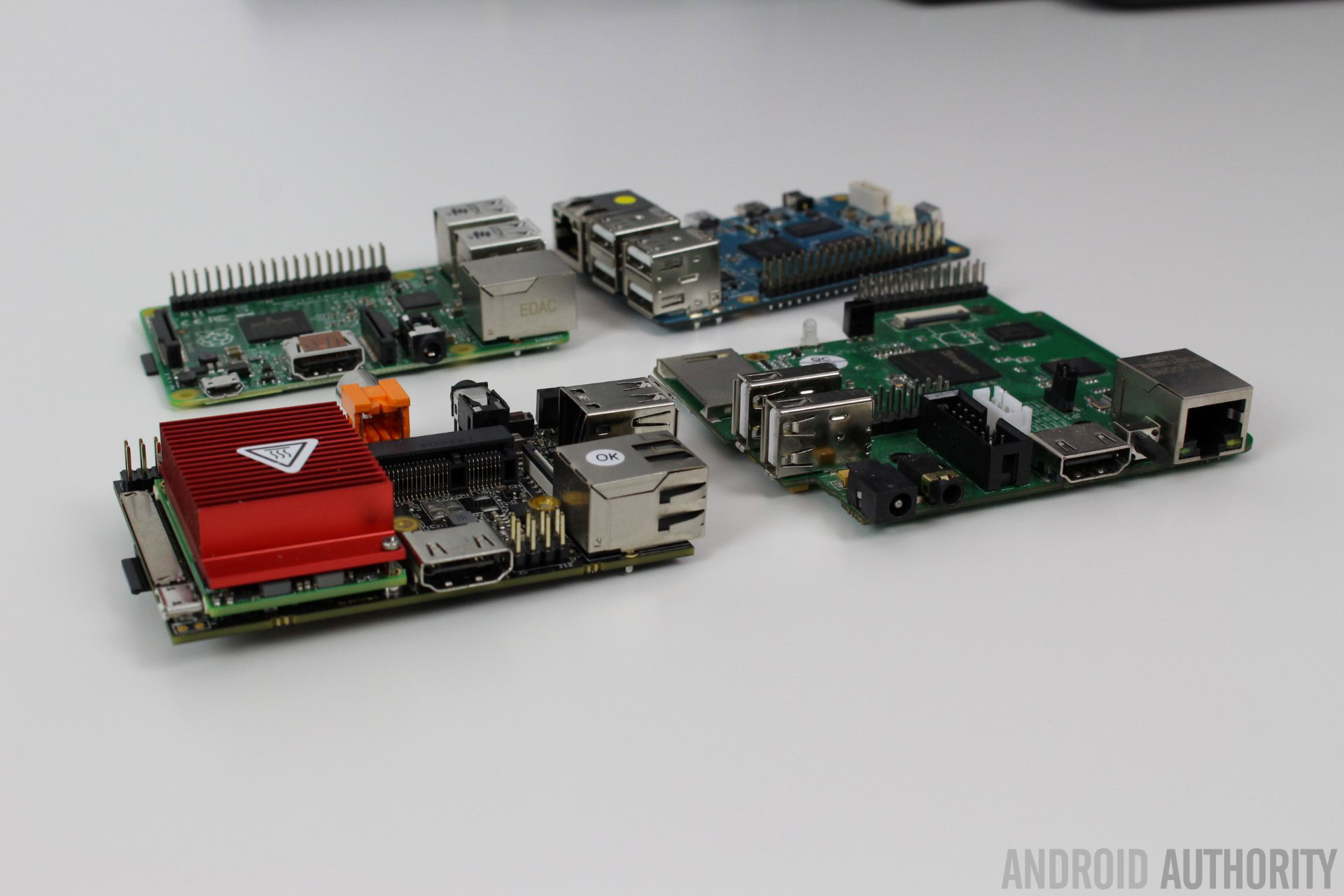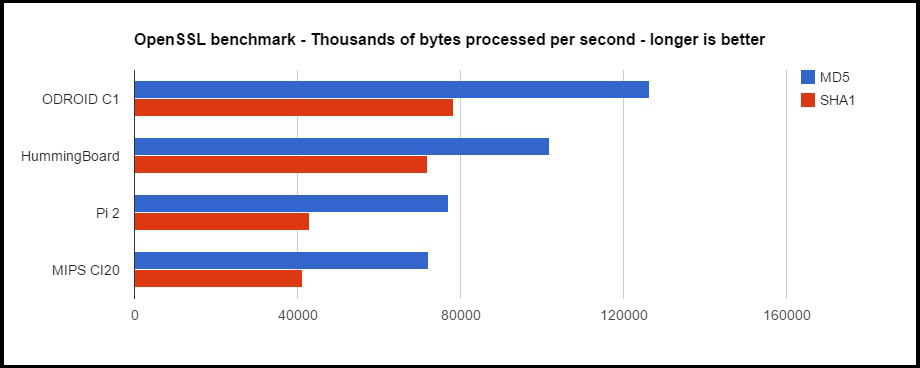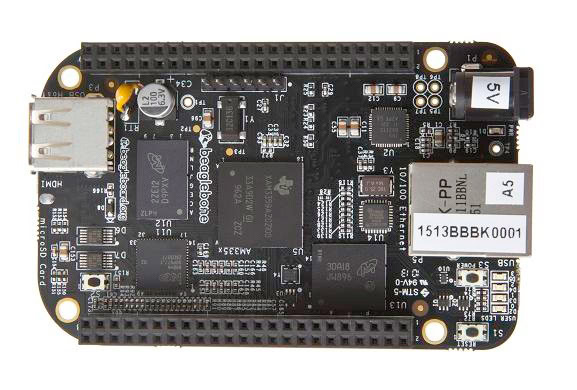Affiliate links on Android Authority may earn us a commission. Learn more.
Showdown: Raspberry Pi 2 vs ODROID C1 vs HummingBoard vs MIPS Creator CI20 (updated)
April 16, 2015
The 2012 release of the original Raspberry Pi created a whole movement of hobbyists, developers, and educationalists, who used the ARM based platform to create, hack, and teach. Although the Raspberry Pi wasn’t the first Single Board Computer (SBC) on the market, it succeeded for three important reasons. First, it was a full computer on a little board, it had a desktop and you could write computer programs on it; Second, it had a set of user programmable GPIO pins, similar to those found on microcontroller platforms like the Arduino; Third, and probably most importantly, it only cost $35.
Since then the SBC market has grown significantly and the Raspberry Pi is no longer the only choice available. Among the popular devices available are the ODROID C1, the HummingBoard, the MIP Creator CI20, and the Raspberry Pi 2. Of course, the list of available boards is much longer, but these are the boards that I have personally tested. At the end of the article I will list some of the other boards that you might to consider, if you don’t find what you are looking for here.

The SBC market is heavily dominated by ARM and three of the four boards that we will be looking at use ARM based processors. The exception is the Creator CI20 which uses a MIPS processor. So before we compare the boards, let me formally introduce you to each one.
[related_videos title=”See the full reviews” align=”center” type=”custom” videos=”588495,598190,584627,576030″]
Although the Raspberry Pi 1 was enormously successful, there was one complaint: the overall performance of the board was lacking, especially when running desktop applications. The performance was less than desirable because it used a single core CPU clock at just 900 MHz. Considering the cost, the innovative nature of the board, and its versatility, then the performance is perfectly understandable, but there was room for improvement. That improvement came in the form of the Raspberry Pi 2, which uses a quad-core processor and doubles the amount of RAM.
Even though the Pi 2 is more powerful and has more memory, the Raspberry Pi foundation managed to keep the price exactly the same. This is a guaranteed recipe for success.
One of the key reasons for the success of the Raspberry Pi was its price. While there are lots of other companies that make SBCs, there aren’t that many who seem to be able to match the Pi’s price point. Of course, some of the boards are only slightly more expensive than the Pi, and to be fair they often offer more functionality, as we will see with the MIPS Creator CI20.
However one company that has managed to build a board for the same basic price as the Raspberry Pi is HardKernel. Called the ODROID C1, it also costs $35. And like the Pi 2, it also uses a quad-core processor and comes with 1GB of RAM. The ODROID C1 isn’t the only SBC that HardKernel make, but it is the cheapest one. Details about the other boards later.
Another company which offers several different SBCs is SolidRun. All of their boards are built around Freescale’s i.MX 6 series of processors. The i.MX 6 range is based on ARM’s Cortex-A9 design, and scales from single- to quad-core.
The HummingBoard i2eX uses a dual-core i.MX 6 processor, comes with 1GB of RAM, and has the same form factor as a Raspberry Pi 1 – it will even fit into a case designed for the first generation Pi.
The one board in our line-up which doesn’t use an ARM based processor is the MIPS CI20 Creator. At its heart is a dual-core MIPS based processor coupled with a PowerVR GPU and backed by 1GB of RAM. It is also unique in that it includes its own built-in storage, plus Wi-Fi and Bluetooth. At just $65, it is more expensive than the ODROID C1 or the Raspberry Pi 2, but you are getting more for your money.
Now that you have been introduced to our four boards, how do they compare on paper? Here is a list of the specifications of each board and how it compares with the others:
| Device | ODROID C1 | Raspberry Pi 2 | HummingBoard i2eX | Creator CI20 |
|---|---|---|---|---|
| Device CPU | ODROID C1 1.5Ghz quad core ARM Cortex-A5 CPU from Amlogic | Raspberry Pi 2 900MHz quad-core ARM Cortex-A7 CPU from Broadcom | HummingBoard i2eX 1GHz i.MX6 dual-core Cortex-A9 CPU | Creator CI20 1.2GHz dual-core Imagination MIPS32 CPU |
| Device GPU | ODROID C1 Mali-450 MP2 GPU | Raspberry Pi 2 Videocore IV | HummingBoard i2eX GC2000 | Creator CI20 PowerVR SGX540 |
| Device Memory | ODROID C1 1GB | Raspberry Pi 2 1GB | HummingBoard i2eX 1GB | Creator CI20 1GB |
| Device Storage | ODROID C1 SD card slot or eMMC module | Raspberry Pi 2 SD card slot | HummingBoard i2eX SD card slot | Creator CI20 8GB onboard flash, SD card slot |
| Device Connectivity | ODROID C1 4 x USB, microHDMI, Gigabit Ethernet, infra red remote control receiver | Raspberry Pi 2 4 x USB, HDMI, Ethernet, 3.5mm audio jack | HummingBoard i2eX 2 x USB, HDMI, Ethernet, 3.5mm audio jack, infra red remote control receiver | Creator CI20 Ethernet, 802.11 b/g/n Wi-Fi, Bluetooth 4.0, 2 x USB, HDMI, 3.5mm audio jack |
| Device OS | ODROID C1 Android, Linux | Raspberry Pi 2 Linux, Windows 10 | HummingBoard i2eX Linux, Android | Creator CI20 Linux, Android |
| Device Connectors | ODROID C1 GPIO, SPI, I2C, RTC (Real Time Clock) backup battery connector | Raspberry Pi 2 Camera interface (CSI), GPIO, SPI, I2C, JTAG | HummingBoard i2eX Camera interface (CSI-2), GPIO, UART, SPI, I2C, PCI-Express Gen 2, mSATA II, RTC with backup battery | Creator CI20 Camera interface (ITU645 controller), 14-pin ETAG connector, 2 x UART, GPIO, SPI, I2C, ADC |
| Device Price | ODROID C1 $35 | Raspberry Pi 2 $35/£24 | HummingBoard i2eX $110 | Creator CI20 $65/£50 |
The two main Android features that distinguish one board from another are support for sound over HDMI, and support for USB flash drives.
Android does however run on the ODROID C1, the HummingBoard and the MIP CI20 Creator. Currently all three only support Android 4.4 KitKat, but each one has the potential to run Android 5.0 Lollipop, however none of the board makers have officially released a ROM at this time.
To judge how well Android is supported on each of the boards I will use the following criteria: features, performance and support for Google’s services.
The two main Android features that distinguish one board from another are support for sound over HDMI and support for USB flash drives. The best board in terms of these features is the ODROID C1. The HummingBoard and the CI20 don’t support USB flash drives under Android, and the CI20 doesn’t support sound over HDMI.
Scoring each board out of 4 for features: the ODROID C1 gets 4, the HummingBoard gets 3, and the CI20 scores 2.
Next, performance. Using AnTuTu as a guide to the relative performance, the ODROID C1 scored 15887, and the HummingBoard-i2eX scored 12198. I wasn’t able to test the CI20, but according to comments I have seen on the Internet, it scores less than the other two.
So, scoring each board out of 4 for performance, the ODROID C1 gets 4, the HummingBoard gets 3, and the CI20 scores 2.
Finally, in terms of support for Google Play and Google’s services: the HummingBoard comes with Google Play pre-installed, whereas the ODROID C1 doesn’t include Google’s services by default, but you can install them via a quick hack. The CI20 doesn’t include support for Google’s service at all.
Therefore scoring each board out of 4 for Google Play support: the HummingBoard gets 4, the ODROID C1 gets 3, and the CI20 scores 2.
Since the Raspberry Pi doesn’t support Android, it will score 0 for this section. The totals for this section are:
- ODROID C1 – 11
- HummingBoard i2eX – 10
- CI20 Creator – 6
- Raspberry Pi – 0
Update (May 2015): Imagination has released a new version of Android for the CI20 with several improvements including audio over HDMI and Bluetooth; new built-in Ethernet settings; audio jack auto-detection (easily switch audio output from HDMI to headphones and vice versa); and audio recording. Also support for USB storage is coming soon.
All four boards support Linux, and they all support it well. To try and judge which board supports Linux the best, I will use the following criteria: the number of distributions supported, performance, and the amount of free memory available after a fresh boot into the desktop.
The board which supports the most Linux distros is the Raspberry Pi 2. Largely due to the sheer size of its user community, the Raspberry Pi is a popular platform and therefore receives the most attention in terms of porting.
The fastest board of the four, in terms of CPU performance without help from the GPU, is the ODROID C1.
The scores for distro support is therefore: Raspberry Pi – 4, ODROID C1 and HummingBoard – tied on 3, and CI20 – 1.
As for performance, the OpenSSL command line tool has a speed option which tests the performance of its various cryptographic algorithms. It also provides a good way to judge the relative performance of one CPU compared to another.

The scores were quite revealing. The fastest board of the four, in terms of CPU performance without help from the GPU, is the ODROID C1. Next comes the HummingBoard, followed by the Raspberry Pi 2. Last place, but not by much, goes to the CI20.
As a result, the scores for performance are: ODROID C1 – 4, HummingBoard – 3, Raspberry Pi 2 – 2, and the CI20 – 1.
Since these boards all have 1GB of RAM, it is important how much free memory remains once the board has booted to the desktop. The graphical user interfaces can be memory hogs and each of the boards uses a lightweight window manager to try and conserve memory. The results are for the default or recommended distro that can boot into the desktop without any additional installation and configuration by the user.
The most frugal board is the Raspberry Pi 2, which had 816360K free after booting. Next comes the CI20, which had 737436K free. The ODROID C1 had 425836K free, and finally the HummingBoard had 313860K free.
So the scores for the free memory test are: – Raspberry Pi 2 – 4, the CI20 – 3, ODROID C1 – 2, and HummingBoard – 1.
Collating all the score for this section, the results of the Linux tests are as follows:
- Raspberry Pi – 10
- ODROID C1 – 9
- HummingBoard i2eX – 7
- CI20 Creator – 5
All four boards should support Kodi/XBMC. To test the performance of Kodi I used its internal codec information display to show the frame rate and the amount of CPU time being used to decode the video. I then produced a Full HD, 50Mbps version of my ZTE Blade S6 Plus review video and played it on each board.
The ODROID C1 and the HummingBoard i2eX both did an excellent job of displaying the video. Both managed consistently to show the video at its full frame rate, and neither taxed the CPU too much in doing so. The same can’t be said for the Raspberry Pi, which disappointingly could only manage 9 fps, instead of the needed 23.97 fps. Unfortunately I couldn’t find an easily accessible version of Kodi to run on the CI20, and neither could I find a video player in the online repositories.
Update: According to The Raspberry Pi Foundation the way Kodi works on the Pi is it bypasses the GUI rendering, which means the frame rate reported by the codec overlay won’t be accurate (i.e. the Pi is actually performing better than reported). As for the mouse lag, this is a known phenomenon and the best results will be achieved when using the keyboard or some form of remote control.
The scores for this section are: ODROID C1 – 4, and HummingBoard – 4, Raspberry Pi 2 – 2, CI20 – 0
In a nutshell, the Raspberry Pi 2 has the widest OS support and the other three are very similar in the level of support offered.
As for the other three boards, they each have a measure of support for different OSes. For example FreeBSD is known to run on the HummingBoard, while NetBSD has been ported to the ODROID C1 and the MIPS CI20 Creator. There is also a work in progress to support OpenWrt on the CI20.
In a nutshell, the Raspberry Pi 2 has the widest OS support and the other three are very similar in the level of support offered. Therefore to score this section I will give the Raspberry Pi 2, 4 points. And the other three, 2 points each.
A big factor in picking an SBC is the size of the various online communities. How many people are there blogging about this board? Making videos about it? Writing books about it? Offering help in forums? And so on.
There is little doubt that the Raspberry Pi community is the largest. This is mainly because of the success of the original Raspberry Pi, however it is already clear that the community has embraced the new Pi 2 board with the same passion. It is hard to judge between the online communities of the ODROID and the HummingBoard, but roughly speaking, in broad terms, they are approximately the same! The CI20 has the smallest of the communities partly due to its relative newness.
As a result, the Raspberry Pi 2 scores – 4, the ODROID C1 and the HummingBoard – 3 each, and the CI20 – 1.
Before we draw our conclusion, I mentioned at the beginning that the boards shown here are the boards that I actually have at hand and can actually test. There are of course many more SBCs available than just these four, and I might have missed off your favorite board. If you can’t find what you are looking for among these SBCs then here are a few more that you might want to check out.
As well as the ODROID C1, HardKernel also makes the high-end $179 ODROID XU3, with a Samsung Exynos 5422 octa-core processor and 2GB of memory; as well as the mid-range $69 quad-core ODROID U3, with its 1.7GHz Exynos 4412 CPU, it also has 2GB of RAM.

Another well respected board is the BeagleBone Black. It uses a 1GHz, single core Cortex-A8 based processor backed by 512MB of RAM. For hardware enthusiasts it is a considered a good choice as the board also includes 2 built-in microcontrollers.
Other boards to consider are the UDOO, the Wandboard, the Banana Pi/Pro, and the Radxa Rock.
And without further ado… The final scores are:
| Device | ODROID C1 | HummingBoard i2eX | Raspberry Pi 2 | MIPS Creator CI20 |
|---|---|---|---|---|
| Device Android tests | ODROID C1 11 | HummingBoard i2eX 10 | Raspberry Pi 2 0 | MIPS Creator CI20 6 |
| Device Linux tests | ODROID C1 9 | HummingBoard i2eX 7 | Raspberry Pi 2 10 | MIPS Creator CI20 5 |
| Device Other OSes, Kodi/XBMC, community size | ODROID C1 9 | HummingBoard i2eX 9 | Raspberry Pi 2 10 | MIPS Creator CI20 3 |
| Device Totals | ODROID C1 29 | HummingBoard i2eX 26 | Raspberry Pi 2 20 | MIPS Creator CI20 14 |
If you need Android support then the ODROID C1 is the clear winner.
But having said that, the community size of the Raspberry Pi is unequaled, so maybe the Pi 2’s shortcomings can be overlooked. There is also the issue of price. The C1 costs the same as the Pi 2, on paper, but the shipping costs can be high if you want it directly from HardKernel. My ODROID C1 actually cost 44 Euros from a European distributor, that is around $46.
However, if you need Android support then the ODROID C1 is the clear winner.
Thank you for being part of our community. Read our Comment Policy before posting.